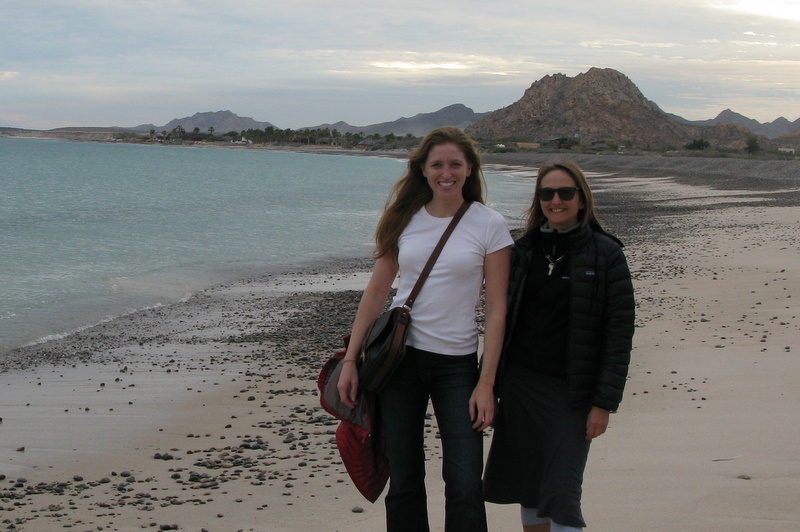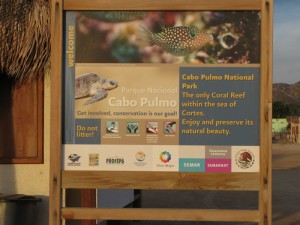Field notes from Cabo Pulmo

In January 2012, our research team also visited Cabo Pulmo, a Mexican national park south of La Paz where fish, sharks, and other marine species have made a tremendous comeback in the last decade, following the creation of a 72 km2 no-take marine reserve. While we know a great deal about the ecological success of Cabo Pulmo, we know far less about social, institutional, and historical questions. For example, what were the social and ecological conditions that enabled this recovery? What could we learn about how the diverse perspectives of fishermen, divers, and scientists enable or inhibit such successes?
Driving the two and a half hour drive over increasingly narrow, bumpy roads between La Paz and Cabo Pulmo, I had plenty of time to imagine what we would find at the end of the road. Octavio Aburto, one of our collaborators at Scripps, first studied the reefs of Cabo Pulmo in 1994, while still a student at UABCS, one of Mexico’s premier marine biology programs. He and his colleagues monitored the reef fish communities of Cabo Pulmo in 1999, four years after the local community began to enforce the reserve. They returned to the area in 2009, and were astonished by how the ecosystem had changed. Gulf groupers larger than any seen elsewhere in the Gulf, dense schools of predatory jacks, and numbers of black tip reef sharks and other top predators that rivaled near-pristine reefs elsewhere in the Pacific, like the Line Islands. See the recent article in PloS One to learn more.
 Cabo Pulmo, a community of less than 200 people, is the epicenter of these startling ecological changes, and far from ‘pristine.’ Water comes from the sierra, electricity from battery-powered generators sprinkled around town, and fish from fishermen living in neighboring communities fringing the rich, rich waters fringing the ‘East Cape’, as this part of Baja California Sur is known. When we eased off the washboard road that leads to Cabo Pulmo, onto a smoother but still unpaved main road through town, I was struck by the mix of cultures: eco resort meets small town Mexico. Tiendas advertising Cerveza Pacifico, hand labeled signs announcing la comida tipica, were sprinkled among modest houses of cinderblocks and palm frond roofs. We also drove by imposing pastel houses surrounded by barbed wire fences, a number of very skinny cattle, brightly painted dive shops, and many, many signs which declared ‘Welcome to Cabo Pulmo,’ in both English and Spanish.
Cabo Pulmo, a community of less than 200 people, is the epicenter of these startling ecological changes, and far from ‘pristine.’ Water comes from the sierra, electricity from battery-powered generators sprinkled around town, and fish from fishermen living in neighboring communities fringing the rich, rich waters fringing the ‘East Cape’, as this part of Baja California Sur is known. When we eased off the washboard road that leads to Cabo Pulmo, onto a smoother but still unpaved main road through town, I was struck by the mix of cultures: eco resort meets small town Mexico. Tiendas advertising Cerveza Pacifico, hand labeled signs announcing la comida tipica, were sprinkled among modest houses of cinderblocks and palm frond roofs. We also drove by imposing pastel houses surrounded by barbed wire fences, a number of very skinny cattle, brightly painted dive shops, and many, many signs which declared ‘Welcome to Cabo Pulmo,’ in both English and Spanish.
Leila and I had come to Cabo Pulmo with our colleague Sheila Walsh, senior scientist with The Nature Conservancy, to hoping to hear some of the stories of those who have been involved in the formation of the national park. We heard the stories of the original champions of the reserve, the Castro family, some of whom now lead dive and sport fishing trips for tourists. We watched David pursue the shadowy forms of the sharks with a camera in the surf just south of the town, and spotted the towering, swirling schools of jacks that Octavio Aburto captured on film during his earlier research trips. We also heard tales of conflict among Cabo Pulmo’s fishermen-turned-tourist operators and fishermen from other nearby towns, and how the Navy and other government authorities have enabled the community of Cabo Pulmo to steward the reef.
Working in collaboration with scientists and the Mexican government, the community of Cabo Pulmo is developing a new model for sustainable tourism in southern Baja. The dream, as Judith Castro described it to us, is to maintain the rustic, environmentally friendly atmosphere of the community, and to expand that vision to other towns in the region. Sitting in the twilight in front of her tienda with her three-year old climbing affectionately all over her lap and hearing her passion for the reef and the town, it all seemed possible. But the social changes that enabled the protection and recovery of Cabo Pulmo’s reef have not been easy, she admitted. Recently, the economic and ecological success of Cabo Pulmo has caught the attention of developers and government officials keen to increase this remote part of the peninsula’s draw as an international tourism destination. Only time will tell whether the success of Cabo Pulmo’s reserve is a lasting one, and what that will mean for the people who live in and visit this area.
